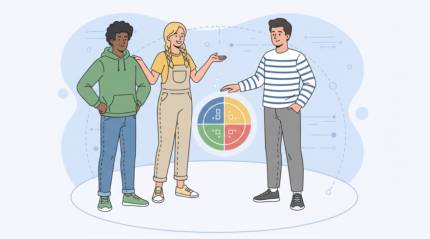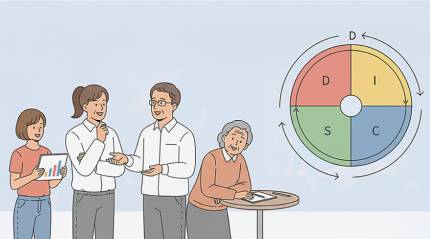The Ultimate Guide to the DISC Model for Practical Growth and Team Success
- 9 October 2025

The DISC framework explains observable behavior, communication tendencies, and motivational drivers in a simple, four-quadrant language. Rather than boxing people in, it offers a shared map that helps colleagues interpret actions with more empathy and clarity. Organizations rely on this model to shorten the learning curve when forming new teams, coaching managers, and designing culture. Its power lies in making nuanced dynamics visible, actionable, and easy to DISCuss without jargon or blame.
Within many organizations, the DISC personality profile serves as a practical entry point to understanding Dominance, Influence, Steadiness, and Conscientiousness as patterns rather than labels. Teams that adopt a common vocabulary can de-escalate conflicts faster and align roles with strengths more precisely. Leaders often adopt the DISC profile as a shared vocabulary that supports hiring, onboarding, feedback, and career development consistently. When the language becomes part of day-to-day rituals, meetings run smoothly, performance conversations become clearer, and collaboration gets easier because expectations are explicit instead of assumed.
How the Four Styles Work Together
The model groups behaviors around results, relationships, pace, and process, which appear in combinations unique to each person. Many practitioners visualize patterns on a circular chart to reveal proximity between traits and tensions across quadrants. In practice, the DISC profile wheel helps teams see why some colleagues prefer fast decisions while others demand thorough data. That simple picture reduces friction by making differences less personal and more structural. As people experiment with new strategies, they can choose responses that match the moment instead of defaulting to habit.
Interpreting reports becomes more powerful when people connect daily actions to strengths, blind spots, and stress signals. Coaches often encourage participants to translate insights into observable commitments for meetings, emails, and handoffs, which makes progress measurable. When managers track growth across projects, the DISC profile analysis turns into a living conversation rather than a one-time event that fades. The following summary organizes core tendencies at a glance to support quick application.
| Style | Core Drivers | Strengths | Watch-outs | Communication Tips |
|---|---|---|---|---|
| Dominance (D) | Results, autonomy, speed | Decisive, bold, goal-focused | Impatience, risk of overstepping | Be brief, focus on outcomes and options |
| Influence (I) | Connection, visibility, enthusiasm | Persuasive, optimistic, energizing | Overpromising, reduced follow-through | Be upbeat, share stories, agree on next steps |
| Steadiness (S) | Harmony, predictability, support | Patient, reliable, team-oriented | Resistance to change, avoiding conflict | Be warm, provide context, allow time |
| Conscientiousness (C) | Quality, accuracy, logic | Thorough, analytical, precise | Overanalyzing, perfectionism | Be clear, share data, explain rationale |
Benefits for Teams, Managers, and Organizations
High-performing groups insist on clarity, and a common behavioral language delivers that clarity faster than trial and error. When everyone can describe their preferences, workload can be shaped to fit strengths while still challenging growth edges. In distributed environments, clearly stated expectations prevent misinterpretations that often occur in chat, tickets, or email threads. For culture builders, the DISC workplace profile provides a grounded way to design rituals that reward healthy collaboration and reduce meeting fatigue. The result is fewer bottlenecks, cleaner handoffs, and a stronger sense of psychological safety.
People leaders also need a dependable way to identify coaching leverage points. Rather than guessing what will motivate a direct report, a structured approach illuminates the why behind common reactions to pressure, change, and feedback. As promotion paths widen, the DISC profile assessment helps align development plans with real behaviors, not assumptions. That alignment makes succession planning more confident, onboarding smoother, and cross-functional projects less chaotic because roles match natural inclinations while still encouraging balanced growth.
- Reduce friction by decoding pace, detail, and decision preferences.
- Improve meetings through roles tailored to strengths and goals.
- Accelerate onboarding with a shared language for expectations.
- Strengthen coaching by linking behaviors to measurable commitments.
- Enhance change management with clearer communication playbooks.
Choosing, Taking, and Trusting an Evaluation
Reliable instruments balance scientific rigor with practical application. Look for tools that translate insights into specific actions you can try in your next one-on-one, sprint planning session, or client call. Providers should explain methodology clearly, DISClose validation research, and offer guidance that respects nuance. For individuals comparing options, the DISC profile test becomes more useful when it pairs concise questions with robust feedback narratives. After you review the results, set two or three commitments you will test in real work to confirm fit.
Teams benefit when the process includes orientation, space for questions, and time to reflect together. Facilitators can debrief patterns at the group level while protecting individual boundaries and avoiding simplistic labeling. To ensure consistent quality, the DISC profile assessment test should come with clear interpretation notes and practical examples relevant to your context. A good debrief invites people to describe their day-to-day obstacles, choose one behavioral experiment, and then revisit outcomes after a defined period.
Access, Cost Considerations, and Buyer Tips
Before choosing a provider, clarify your goals, the audience size, and the level of facilitation you want. Some organizations prefer self-serve reports, while others invest in certified coaching to maximize impact. If the budget is tight, pilot with a small cohort and measure changes in handoffs, cycle time, or satisfaction to justify expansion. For individuals dipping a toe into behavior tools, the free DISC profile can introduce core ideas and spark curiosity about the four styles. As interest grows, upgrading to a validated instrument will deepen accuracy and practical guidance.
When comparing offers, examine report depth, group analytics, integration options, and support. Transparent vendors will outline data privacy, retest policies, and how they continuously improve their instruments. You can also ask about benchmarks for roles like sales, support, or engineering to tailor development plans. For learners exploring entry-level options, some providers advertise a DISC profile test free entry point that includes a brief narrative and simple tips. As your needs mature, prioritize tools that connect insights to workflows, templates, and manager enablement.
- Validate methodology and psychometrics before rollout.
- Start with a pilot and track tangible business outcomes.
- Blend individual insights with team-level practices.
- Protect privacy and keep participation voluntary where possible.
- Translate findings into experiments you can evaluate in weeks, not months.
Implementing Insights and Sustaining Momentum
Insights turn into value only when they become habits. Convert each takeaway into a clear behavior that shows up in recurring moments such as standups, status updates, retrospectives, or customer meetings. Managers can model curiosity by asking colleagues which conditions help them do their best work, then adapting the environment accordingly. Across a quarter, regular check-ins make progress visible and reinforce the behaviors that produce results. Because follow-through matters most, teams that schedule refreshers maintain gains long after initial DISC profile testing is complete. That cadence keeps the language alive and prevents backsliding under pressure.
Practical tools help people remember commitments when schedules get busy. Create short prompts for meeting agendas, email templates for difficult feedback, and cue cards for conflict de-escalation. Consider pairing teammates with complementary strengths to balance pace and precision on high-stakes projects. For individuals who want a lightweight introduction before a bigger investment, some platforms provide a DISC profile free test that covers fundamentals and simple reflection prompts. After experimenting for a few weeks, you can decide whether deeper coaching or a more comprehensive instrument would unlock further improvement.
FAQ: Common Questions About the DISC Model
- Is this a personality tool or a behavior tool?
The framework focuses on observable behavior in context rather than fixed traits, which makes it excellent for practical coaching, communication planning, and team alignment. It highlights how people tend to act under various conditions and how they can adapt to different situations.
- How accurate are the results over time?
Well-constructed instruments show strong test-retest reliability, especially when respondents answer based on recent work situations. That said, context matters, and shifts in role, workload, or stress can influence how preferences show up in daily routines.
- Can teams use the model without a facilitator?
Yes, small groups can self-lead by reviewing styles together, agreeing on norms, and capturing concrete behaviors for meetings, feedback, and decision-making. Many teams still benefit from a guided debrief to avoid stereotyping and to translate insights into action.
- How should managers apply insights fairly?
Managers should use the language to expand options, not to limit people. The best practice is to DISCuss preferences, co-create agreements, and revisit them during one-on-ones, ensuring flexibility as responsibilities change.
- What are the biggest mistakes to avoid?
Common pitfalls include labeling colleagues, assuming one style is “best,” and skipping follow-up after the initial excitement. To avoid these traps, anchor insights to measurable commitments and check progress on a regular cadence.



